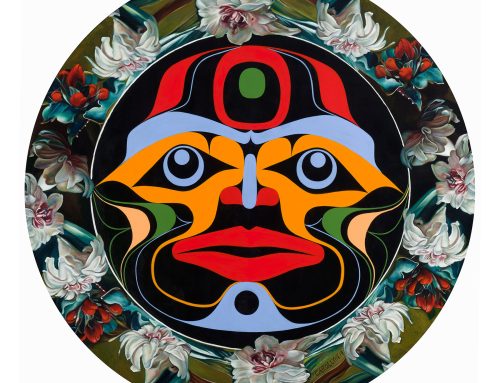Project Description
Website: https://www.arttoronto.ca
Art Toronto 2017
SOLO Booth: #S11
Rande and Carollyne Collective (Rande Cook and Carollyne Yardley)
October 27 – 30, 2017
Fazakas Gallery’s SOLO theme Collaboration features a unique partnership between two Canadian artists, Chief Rande Cook (Kwakwaka’wakw) and Carollyne Yardley, as an aesthetic response to the relationships and exchanges between native and non-native communities, and how these relationships are healing and flourishing through cross-cultural exchanges.
Collaboration builds on these artists’ history of creative fusion initiated in their two-person exhibition Shapeshifting(2017), which included the history of Northwest Coast portrait masks, allegories for understanding adaption, the role of balance, and the necessity of bringing traditional forms of Northwest Coast design to the forefront of contemporary art, and Ravenous (2014), which used personal identities (the trickster Raven and secrets of the squirrel mask), humour, and storytelling to engage and remind viewers that art is alive, influenced, and constantly changing.
For their SOLO exhibition, Cook and Yardley also drew inspiration from traditional Kwakwaka’wakw origin stories and cosmology, weaving a visual dialogue between the artists’ own unique concepts about creation and space-time to describe an interest in the ongoing investigation into the animation of the human existence.
The concept of Collaboration is influenced by Cook’s masterful use of traditional Kwakwaka’wakw iconography seen on Northwest Coast potlatch regalia, and Yardley’s self-coined term ‘Squirrealism’ used to describe a deep exploration of metamorphosis and identity through her richly detailed neo-classical inspired paintings of masks and hybrid/animal beings. The result is an energetic body of work that poetically exhibits the tension and synchronicity inherent in creation of entirely new visual and material forms.
The works extend beyond simplistic expressions of hybridity whereby histories or visuality are sutured in material form. Rather they are the products of deep deconstruction by the artists of both western and indigenous art histories, spiritualities, and experiences. The body of work brings a new line to bear on the role contemporary art plays in intercultural dialogues of cultural histories and shared futures.

Metamorphosis/ Tlayilela Mask
Rande Cook and Carollyne Yardley
Cedar, acrylic, oil, abalone, horsehair, 10” x 8” x 6”
Photo credit: Terry Zlot

Collaboration Mask (front view), Rande Cook and Carollyne Yardley, Cedar, acrylic, oil, human hair, silver, 9.5” x 6” x 4.5”, 2016. Photo credit: Terry Zlot

Collaboration Mask (right view), Rande Cook and Carollyne Yardley, Cedar, acrylic, oil, human hair, silver, 9.5” x 6” x 4.5”, 2016. Photo credit: Terry Zlot

Collaboration Mask (left view), Rande Cook and Carollyne Yardley, Cedar, acrylic, oil, human hair, silver, 9.5” x 6” x 4.5”, 2016. Photo credit: Terry Zlot

There’s a Squirrel on my Forehead, Cedar, acrylic, oil, abalone, human hair, horsehair, cedar bark, 10” x 9” x 7”2017, Rande Cook, and Carollyne Yardley


















